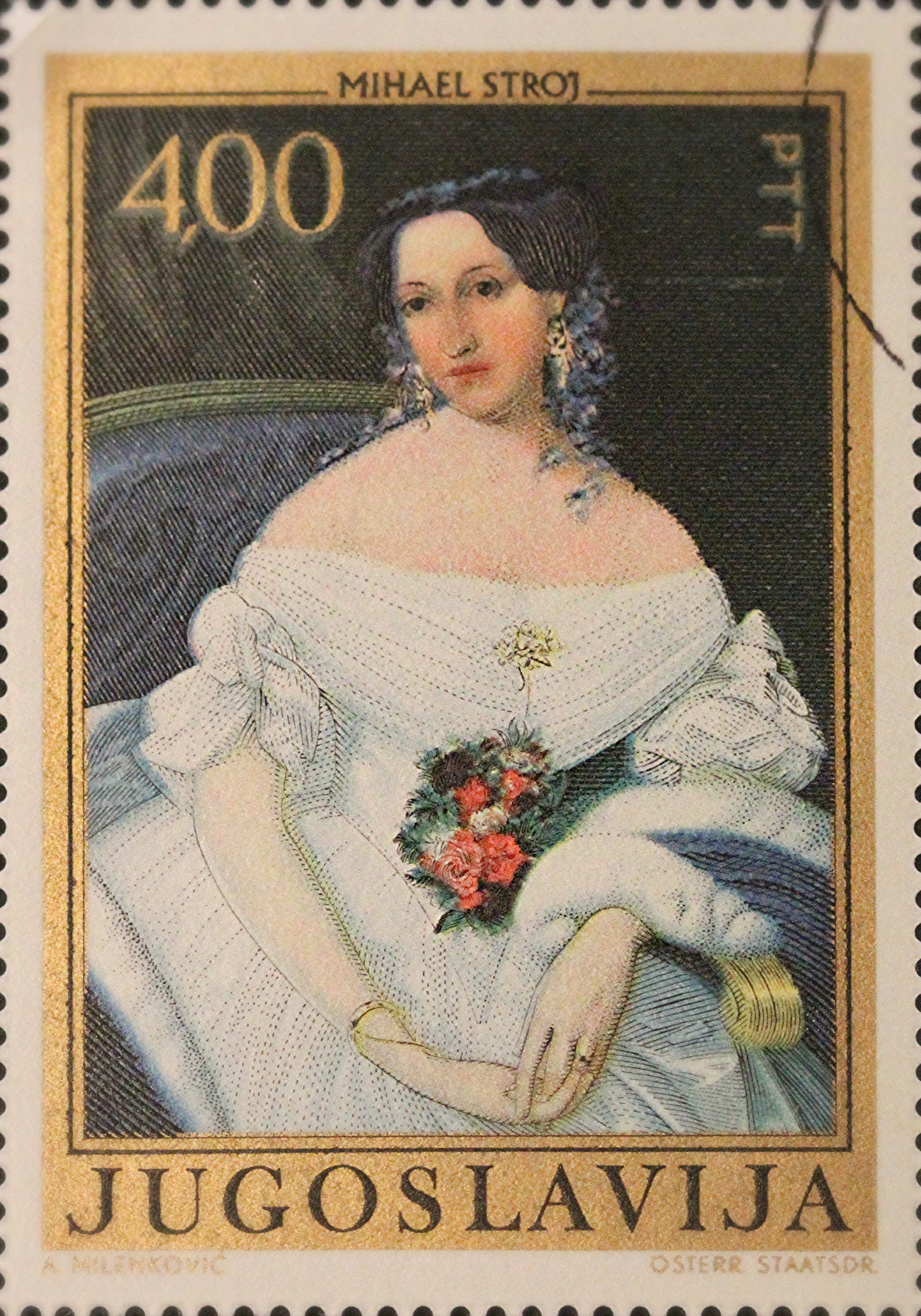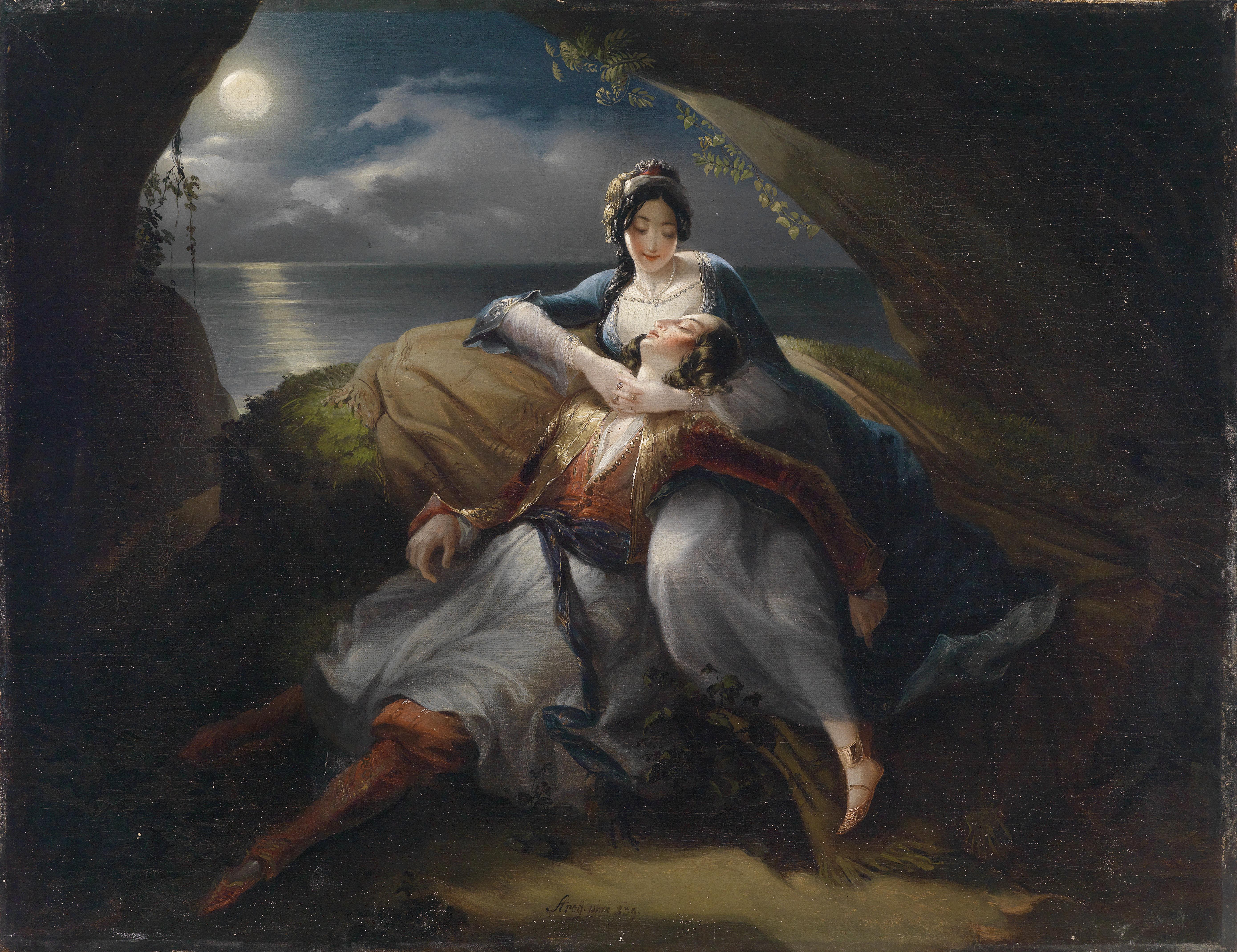Michael Stroy on:
[Wikipedia]
[Google]
[Amazon]
 Michael Stroy (Slovenized: ''Mihael Stroj'', 30 September 1803 in
Michael Stroy (Slovenized: ''Mihael Stroj'', 30 September 1803 in
 Michael Stroy was born the fifth of eight children to Anton Stroy and his wife Maria, née Kokail. He spent his childhood in
Michael Stroy was born the fifth of eight children to Anton Stroy and his wife Maria, née Kokail. He spent his childhood in

 Michael Stroy was one of the most prominent
Michael Stroy was one of the most prominent
File:Mihael Stroj - Azija.png, Azija
File:Mihael Stroj - Portret Luize Pesjak.jpg, Portrait of Luiza Pesjak II
File:Mihael Stroj - Mož z rdečo pentljo.jpg, Portrait of a man
File:Blaž Crobath.jpg, Portrait of Dr. Blaž Crobath, c. 1842
File:Mihael Stroj - Kristofor Stanković.jpg, Kristofor Stanković
File:Mihael Stroj - Portret Therese Proch.jpg, Therese Proch
File:Mihael Stroj - Evropa.jpg, Europa
 Michael Stroy (Slovenized: ''Mihael Stroj'', 30 September 1803 in
Michael Stroy (Slovenized: ''Mihael Stroj'', 30 September 1803 in Ljubno
Ljubno ob Savinji (; german: Laufen''Leksikon občin kraljestev in dežel zastopanih v državnem zboru,'' vol. 4: ''Štajersko''. 1904. Vienna: C. Kr. Dvorna in Državna Tiskarna, p. 44.) is the largest town and the centre of the Municipality of L ...
– 19 December 1871 in Ljubljana
Ljubljana (also known by other historical names) is the capital and largest city of Slovenia. It is the country's cultural, educational, economic, political and administrative center.
During antiquity, a Roman city called Emona stood in the ar ...
) was an Austro-Hungarian
Austria-Hungary, often referred to as the Austro-Hungarian Empire,, the Dual Monarchy, or Austria, was a constitutional monarchy and great power in Central Europe between 1867 and 1918. It was formed with the Austro-Hungarian Compromise of ...
painter of Slovenian
Slovene or Slovenian may refer to:
* Something of, from, or related to Slovenia, a country in Central Europe
* Slovene language, a South Slavic language mainly spoken in Slovenia
* Slovenes
The Slovenes, also known as Slovenians ( sl, Sloven ...
origin.
Life
 Michael Stroy was born the fifth of eight children to Anton Stroy and his wife Maria, née Kokail. He spent his childhood in
Michael Stroy was born the fifth of eight children to Anton Stroy and his wife Maria, née Kokail. He spent his childhood in Ljubno
Ljubno ob Savinji (; german: Laufen''Leksikon občin kraljestev in dežel zastopanih v državnem zboru,'' vol. 4: ''Štajersko''. 1904. Vienna: C. Kr. Dvorna in Državna Tiskarna, p. 44.) is the largest town and the centre of the Municipality of L ...
in Upper Carniola
Upper Carniola ( sl, Gorenjska; it, Alta Carniola; german: Oberkrain) is a traditional region of Slovenia, the northern mountainous part of the larger Carniola region. The centre of the region is Kranj, while other urban centers include Jeseni ...
. In 1812, his mother died of exhaustion. Shortly thereafter, his father remarried, sold his property in Ljubno and moved to Ljubljana
Ljubljana (also known by other historical names) is the capital and largest city of Slovenia. It is the country's cultural, educational, economic, political and administrative center.
During antiquity, a Roman city called Emona stood in the ar ...
with his family. Michael Stroy attended the ''Glavna vzorna šola'', where he completed the fourth class in 1817 with very good grades. He then joined the so-called artists' class, which he concluded in 1820 with distinction. He continued his schooling in Vienna
en, Viennese
, iso_code = AT-9
, registration_plate = W
, postal_code_type = Postal code
, postal_code =
, timezone = CET
, utc_offset = +1
, timezone_DST ...
, where he enrolled in the Academy of Fine Arts
The following is a list of notable art schools.
Accredited non-profit art and design colleges
* Adelaide Central School of Art
* Alberta College of Art and Design
* Art Academy of Cincinnati
* Art Center College of Design
* The Art Institute o ...
in 1821. The first of his works known to have survived, a sketch of a head and a self-portrait, date from this period. It is known that Stroy was still a student at the Academy of Fine Arts in 1825, but it is not known whether he concluded his studies there.
In 1830, Stroy spent time in Zagreb
Zagreb ( , , , ) is the capital (political), capital and List of cities and towns in Croatia#List of cities and towns, largest city of Croatia. It is in the Northern Croatia, northwest of the country, along the Sava river, at the southern slop ...
, where he offered his services to the nobility and bourgeoisie as a portraitist. Because of the numerous commissions that he received, he remained in Zagreb. He lived in Croatia
, image_flag = Flag of Croatia.svg
, image_coat = Coat of arms of Croatia.svg
, anthem = "Lijepa naša domovino"("Our Beautiful Homeland")
, image_map =
, map_caption =
, capit ...
(with intermittent stays in Slovenia
Slovenia ( ; sl, Slovenija ), officially the Republic of Slovenia (Slovene: , abbr.: ''RS''), is a country in Central Europe. It is bordered by Italy to the west, Austria to the north, Hungary to the northeast, Croatia to the southeast, an ...
) until 1842. In this period, he painted not only a large number of portraits, but also works with religious content, including altar pictures for churches in Vugrovec and Nova Rača.
In Croatia, Stroy was exposed to the ideas of Illyrism
The Illyrian movement ( sh-Latn-Cyrl, Ilirski pokret, Илирски покрет; sl, Ilirsko gibanje) was a pan-South-Slavic cultural and political campaign with roots in the early modern period, and revived by a group of young Croatian inte ...
and associated with members of the Illyrian movement, including Stanko Vraz
Stanko Vraz (born Jakob Frass; 30 June 1810 – 20 May 1851) was a Slovenian- Croatian poet. He Slavicized his name to ''Stanko Vraz'' in 1836.
Biography
Born in the village of Cerovec in Lower Styria, Austrian Empire (today in Slovenia), Vraz ...
, Djuro Jelačić, the Ožegović family and others.
In 1841, Stroy married Margareta Berghaus, which whom he had five daughters. The following year, he returned to Ljubljana, where he continued to paint portraits of important members of the local bourgeoisie, although he also received further commissions from Croatia. He died in his house in Ljubljana after suffering multiple heart attacks.
Stroy used his baptismal name, ''Michael Stroy'', throughout his life, and it is also the name entered in his death record. The Slovenized spelling ''Mihael Stroj'' first appeared about a decade after the artist's death.
Work

 Michael Stroy was one of the most prominent
Michael Stroy was one of the most prominent Slovenia
Slovenia ( ; sl, Slovenija ), officially the Republic of Slovenia (Slovene: , abbr.: ''RS''), is a country in Central Europe. It is bordered by Italy to the west, Austria to the north, Hungary to the northeast, Croatia to the southeast, an ...
n painters of the 19th century. His art reflects the Classicism
Classicism, in the arts, refers generally to a high regard for a classical period, classical antiquity in the Western tradition, as setting standards for taste which the classicists seek to emulate. In its purest form, classicism is an aestheti ...
and the Romanticism
Romanticism (also known as the Romantic movement or Romantic era) was an artistic, literary, musical, and intellectual movement that originated in Europe towards the end of the 18th century, and in most areas was at its peak in the approximate ...
of his day, but the influence of the Biedermeier
The ''Biedermeier'' period was an era in Central Europe between 1815 and 1848 during which the middle class grew in number and the arts appealed to common sensibilities. It began with the Congress of Vienna at the end of the Napoleonic Wars in ...
style is also visible. Most of his works are oil painting
Oil painting is the process of painting with pigments with a medium of drying oil as the binder. It has been the most common technique for artistic painting on wood panel or canvas for several centuries, spreading from Europe to the rest of ...
s, which he signed ''Stroy''.
Portraits of rich members of the bourgeoisie in Ljubljana and in Zagreb made up the majority of his work, although he also painted religious motives, genre works
Genre art is the pictorial representation in any of various media of scenes or events from everyday life, such as markets, domestic settings, interiors, parties, inn scenes, work, and street scenes. Such representations (also called genre works, ...
and historical themes. Some of his paintings are listed below.
Portraits
*J. Martinčič (1830) *Djuro Jelačić (1832) *Karlo Jelačić (1834) *Stjepan Ožegović (1837) *Julijana Gaj (1838) *Mož z rdečo ovratnico (1840) *Stanko Vraz (1841) *Dr. Blaž Crobath (1842) *Mihael Ambrož (1850) *Luiza Pesjak
Luiza Pesjak or Lujiza Pesjakova (12 June 1828 – 31 March 1898) was a Slovene writer, poet and translator. She was the first woman to author a novel in Slovene.
Early life and education
Pesjak was born in Ljubljana on 12 June 1828 and baptized ...
ova (around 1855)
*Škof Anton Alojzij Wolf (1857)
*Ljubljanska meščanka (1858)
*Škof Mirko Karlo Raffay (around 1830)
*Škof Juraj Haulik (1840)
Genre and historical works
*Izpad iz trdnjave Siget (1820s) *V kovačnici (1838) *Historični prizor (?) *Vilinski ples (?) *Orientalka (?)Religious works
*Božja skrb (1842) *Marija pomagaj (?) *Marija z Jezusom na prestolu (1857) *Sv. Florijan (around 1855) *Sv. Anton Puščavnik (1863)Paintings
References
*Mihael Stroj – 1803–1871, (retrospektivna razstava, Ljubljana, Narodna galerija, 26. marec – 16. maj 1971), Ljubljana, Narodna Galerija, 1971 *Klasicizem in romantika na Slovenskem, Ljubljana, Narodna galerija, 1954 *Stele France, Slovenski slikarji, Ljubljana, Slovenski knjižni zavod, 1949 *Komelj Milček, Obrazi – slovensko slikarstvo XIX. stoletja = Gesichter – slowenische Malerei im XIX. Jahrhundert *Komelj Milček, Božja skrb – Mihael Stroj: Božja skrb, Vzgoja, Leto 6, št. 22 (jun. 2004), str. 36. {{DEFAULTSORT:Stroy, Michael 1803 births 1871 deaths Slovenian painters Slovenian male painters Academy of Fine Arts Vienna alumni 19th-century Slovenian painters 19th-century male artists People from the Municipality of Ljubno